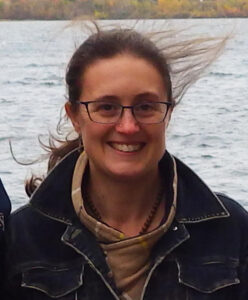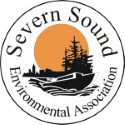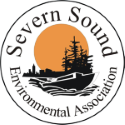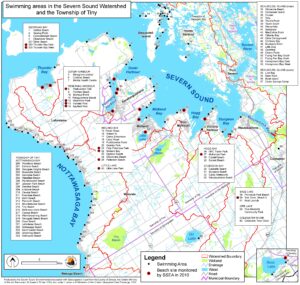Beach Quality
Public swimming areas in Severn Sound were monitored by SSEA during the summer months from the early 1990’s to 2010. Swimming areas are now monitored by the Simcoe Muskoka District Health Unit (SMDHU). Areas in Georgian Bay Islands National Park are monitored by Parks Canada staff provincial parks are monitored by Ontario Parks staff.
Find out about recreational water quality in your area:
Find out about recreational water quality in your area:
Most frequent questions and answers
When the daily geometric mean of samples for a swimming area exceeds 100 E. coli per 100 ml, an advisory from the Health Unit is issued, and a sign stating, “UNSAFE FOR BATHING, HIGH LEVELS OF BACTERIA IN THESE WATERS MAY POSE A RISK TO YOUR HEALTH” is posted at the beach. The swimming area is also re-sampled within a few days, to assess whether E. coli counts have decreased or remain elevated. Note that the assessment and decision to post the swimming area is based on samples that were collected prior to the posting date due to the time taken in analysis of samples. The advisory is removed only after satisfactory results of monitoring have been received by the Health Unit.
Sources of bacterial contamination can include:
- Stormwater washing fecal matter off streets, lawns and parks into nearby waters during rain events
- Poorly maintained or failing septic systems which can leak into waters near swimming areas
- Overflows from combined sewers that carry both sewage and stormwater in urban areas can discharge to waters near swimming areas during and after storm events
- Agricultural activities involving manure storage and handling can contribute to elevated bacteria when runoff enters waters near swimming areas
- Large numbers of waterfowl using a limited section of shoreline
Minimize your impact:
- Observe stoop and scoop bylaws and dispose of pet waste properly
- Perform regular maintenance on septic systems and keep them in good working order
- Naturalize shorelines with native plants instead of mowed lawns to discourage large numbers of waterfowl from using swimming areas
- In rural areas, follow agricultural best management practices to control sources of bacteria from livestock
- In urban areas, minimize runoff from your property. For example, directing eavestrough downspouts onto the ground encourages infiltration rather than runoff to storm sewers.
Aisha Chiandet, Water Scientist, Limnologist achiandet@severnsound.ca 705-534-7283 ext. 204



